Tourbillon
In horology, a tourbillon (/tʊərˈbɪljən/; French: [tuʁbijɔ̃] "whirlwind") is an addition to the mechanics of a watch escapement to increase accuracy. It was developed around 1795 and patented by the French-Swiss watchmaker Abraham-Louis Breguet on June 26, 1801. In a tourbillon the escapement and balance wheel are mounted in a rotating cage, in order to negate the effects of gravity when the timepiece (thus the escapement) is stuck in a certain position. By continuously rotating the entire balance wheel/escapement assembly at a slow rate (typically about one revolution per minute), the tourbillon averages out positional errors.
Originally an attempt to improve accuracy, tourbillons are still included in some expensive modern watches (Swiss models, such as those by TAG Heuer and Frédérique Constant, start at around $15,000) as a novelty and a demonstration of watchmaking virtuosity. The mechanism is usually exposed on the watch's face to showcase it.
Mechanics of the tourbillon
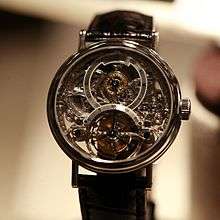
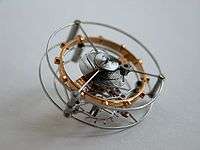
Gravity directly affects the most delicate parts of the escapement, namely the pallet fork, balance wheel and hairspring. Most important is the hairspring, which functions as the timing regulator for the escapement and is thus the part most sensitive to exterior effects, such as magnetism, shocks, temperature, as well as inner effects such as pinning positions (inner collet), terminal curve, and heavy points on the balance wheel.
Many inventions have been developed to counteract these problems. Temperature and magnetism problems have been eliminated with new materials. Shocks have much less effect today than at Breguet's time thanks to stronger and more resilient materials. The oscillator still gets disturbed at the moment of the shock, but the hairspring is not as easily deformed from shocks as before, and re-stabilizes itself quickly after such an event.
Gravity comes into play on the remaining effects. One of them is easily taken away, namely heavy points on the balance wheel. This leaves pinning point and terminal curve. Both of these add a lot of variation to the regulation of a watch: assembly, regulation adjustments by the watchmaker, positioning in the watch, and later position changes by the owner. As the balance wheel goes from one extreme position to the other in its swing back and forth, the hairspring's coils extend and contract a great deal, leading to problems that are extremely hard to counteract. Some have tried using hairsprings that are cylindrical or even spherical instead of flat as is prominent today. Some variations of Breguet's overcoil have been developed to counteract the effects of the terminal curve. As for the pinning point, Grossmann, Berthoud, Breguet, Caspari and Leroy[1] tried many different possibilities, but not much improvement was gained.
The biggest obstacle to regulating a watch, even today, is getting a constant impulse from the escapement regardless of its spatial orientation. This has been made much easier with accurate timing instruments which give instantaneous results, whereas in Breguet's time all that watchmakers had was another watch to regulate from. So, results were not very exact and it could take weeks to get them. Effects of gravity on an escapement can have quite significant effects with slight variations of position. Even if a pocket watch was kept most of the time in a breast pocket, the exact position could still vary over 45°. Watchmakers can regulate a watch in up to eight positions: dial up, crown down, dial down, crown left, crown up, crown right, half-way position crown up, and half-way position crown down.[2] A tourbillon quite neatly reduces this problem; it only needs to be regulated for three positions: the two horizontal positions, dial up & down, and one vertical position.
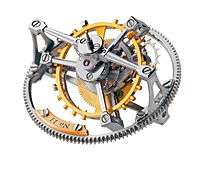
Even with new materials and improved theories, it is impossible to regulate a mechanical watch so it keeps the same time in all positions. A tourbillon offers watchmakers the possibility of higher accuracy than conventional movements, although poising the balance well and ensuring that the balance spring expands and contracts symmetrically can achieve nearly the same result. A tourbillon typically makes one complete revolution per minute. This improves timekeeping in the four vertical positions because even if a watch is stationary in a random vertical position, the tourbillon makes the escapement turn around its own axis, effectively cancelling the effect of gravity by turning the balance through all possible vertical positions during its rotation. A normal tourbillon has no effect in horizontal positions, since the horizontal balance is not affected by gravity as it turns.
A tourbillon has no effect on the change in rate that accompanies a change in attitude from dial horizontal (dial up or down) to dial vertical (pendant up, down, left or right). The change in rate between horizontal and vertical is much greater than rate changes between different vertical positions. Breguet designed the tourbillon for pocket watches that are kept in a vertical position in the waistcoat pocket, and can be maintained in this vertical position overnight by hanging on a suitable stand. In this attitude a tourbillon is effective. However, the attitude of a wristwatch changes frequently from vertical to horizontal depending on the wearer's hand movement. The effect of a tourbillon is small compared to the change in rate resulting from changes from vertical to horizontal, and vice versa. Inclined tourbillons such as those made by Greubel Forsey are an improvement in this regard.
Mechanical watches are now purchased by those who value craftsmanship and aesthetics over very accurate timing. Most tourbillons use standard Swiss lever escapements, but some have a detent escapement.
The tourbillon is considered to be one of the most challenging of watch mechanisms to make[3][4] (although technically not a complication itself) and is valued for its engineering and design principles. The first production tourbillon mechanism was produced by Breguet for Napoleon in one of his carriage clocks. (Travel clocks of the time were of considerable weight, typically weighing almost 200 pounds.)
Types of tourbillon
Double-axis tourbillon
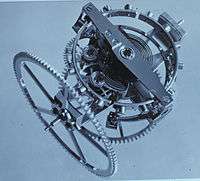
Anthony Randall invented the double-axis tourbillon in January 1977 and subsequently patented it.[5][6] The first working example was later constructed by Richard Good in 1978. In 1980 Anthony Randall made a double-axis tourbillon in a carriage clock, which was located in the (now closed) Time Museum in Rockford, Illinois, US, and was included in their Catalogue of Chronometers.[7]
In 2003, inspired by this invention, the young German watchmaker Thomas Prescher developed for the Thomas Prescher Haute Horlogerie the first flying double-axis tourbillon in a pocket watch and, in 2004, the first flying double-axis tourbillon with constant force in the carriage in a wristwatch. Shown at the Baselworld 2003 and 2004 in Basel, Switzerland.
A characteristic of this tourbillon is that it turns around two axes, both of which rotate once per minute. The whole tourbillon is powered by a special constant-force mechanism, called a remontoire.[8] Prescher invented the constant-force mechanism to equalize the effects of a wound and unwound mainspring, friction, and gravitation. Thereby even force is always supplied to the oscillation regulating system of the double-axis tourbillon. The device incorporates a modified system after a design by Henri Jeanneret.[9]
Double and quadruple tourbillons
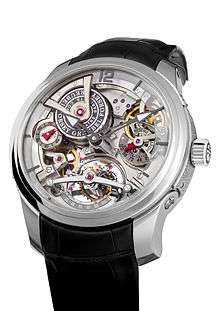
Robert Greubel and Stephen Forsey launched the brand Greubel Forsey in 2004 with the introduction of their Double Tourbillon 30° (DT30). Both men had been working together since 1992 at Renaud & Papi, where they developed complicated watch movements. The Double Tourbillon 30° features one tourbillon carriage rotating once per minute and inclined at 30°, inside another carriage which rotates once every four minutes. In 2005, Greubel Forsey presented their Quadruple Tourbillon à Différentiel (QDT), using two double-tourbillons working independently. A spherical differential connects the four rotating carriages, distributing torque between two wheels rotating at different speeds.
Triple-axis tourbillon
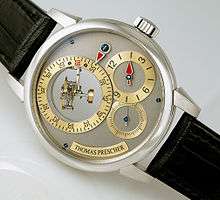
In 2004, Thomas Prescher developed the first triple-axis tourbillon for the Thomas Prescher Haute Horlogerie[10] with constant force in the carriage in a wristwatch. It was presented at Baselworld 2004 in Basel, Switzerland, in a set of three watches including a single-axis, a double-axis and a triple-axis tourbillon.
The world's unique tri-axial tourbillon movement for wristwatch, with traditional jewel bearings only, was invented by the independent watchmaker Aaron Becsei, from Bexei Watches, in 2007. The Primus wristwatch was presented at the Baselworld 2008 in Basel, Switzerland.[11] In the three axis tourbillon movement, the 3rd (external) cage has a unique form which provides the possibility of using jewel bearings everywhere, instead of ball-bearings. This is a unique solution at this size and level of complication.[12] There are a few wrist and pocket watches that include the Triple Axis or Tri-Axial Tourbillon escapements. Examples of companies and watchmakers that include this mechanism are Vianney Halter in his "Deep Space" watch, Thomas Prescher, Aaron Becsei, Girard-Perregaux with the "Tri-Axial Tourbillon" and Jaeger Le-Coultre with the "Gyrotourbillon".
Flying tourbillon
Rather than being supported by a bridge, or cock, at both the top and bottom, the flying tourbillon is cantilevered, being only supported from one side. The first flying tourbillon was designed by Alfred Helwig, instructor at the German School of Watchmaking, in 1920.[13]
In 1993, Kiu Tai-Yu, a Chinese watchmaker residing in Hong Kong, created a semi-flying tourbillon with only an abbreviated carriage for the escapement wheel and pallet fork, the upper pivot of the balance wheel being supported in a sapphire bridge.
Gyro tourbillon
Jaeger-LeCoultre's first wristwatch tourbillon was introduced in 1993 (though JLC had produced tourbillons prior to that, including the famous observatory competition caliber 170) and in 2004 the company introduced the Gyrotourbillon I. Gyrotourbillon I is a double-axis tourbillon with a perpetual calendar and equation of time, and since then, Jaeger-LeCoultre has gone on to produce several variations on the multi-axis tourbillon theme. In general, however, these have been fairly thick watches (Gyrotourbillon I is 16mm thick) but with the Reverso Tribute Gyrotourbillon, JLC has produced a thinner and much more wearable version of its multi-axis tourbillon. At 51.1mm x 31mm x 12.4mm it's still not a small watch, but it is very comfortable on the wrist and certainly easier to wear than some of its predecessors.
Modern tourbillon watches
In modern mechanical watch FILMS, a tourbillon is not required to produce a highly accurate timepiece; there is even debate amongst horologists as to whether tourbillons ever improved the accuracy of mechanical time pieces, even when they were first introduced, or whether the time pieces of the day were inherently inaccurate due to design and manufacturing techniques. Nevertheless, the tourbillon is one of the most valued features of collectors' watches and premium timepieces,[14] possibly for the same reason that mechanical watches fetch a much higher price than similar quartz watches that are much more accurate.[15] High-quality tourbillon wristwatches, usually made by the Swiss luxury watch industry, are very expensive, and typically retail for tens of thousands of dollars or euros, with much higher prices in the hundreds of thousands of dollars or euros being common. A recent renaissance of interest in tourbillons has been met by the industry with increased availability of time pieces bearing the feature, with the result that prices for basic tourbillon models have receded somewhat in recent years (whereas previously they were very rare, in either antiques or new merchandise); however, any time piece that has a tourbillon will cost a great deal more than an equivalent piece without the feature. Swiss models typically start at $40,000, and higher end tourbillon watches can be six figures, whereas some Chinese three-axis make and models range from hundreds to nearly $5000.[16]
Modern implementations typically allow the tourbillon to be seen through a window in the watch face. In addition to enhancing the charm of the piece, the tourbillon can act as a second hand for some watches as it generally rotates once per minute. However some tourbillons spin faster (Greubel Forsey's 24-second tourbillon for example). There are many watches that feature the oscillating balance wheel visible through the watch dial that are not tourbillons. This feature is often referred to as the "open heart" though it is often called a tourbillon by unscrupulous dealers (and tourbillon-style by scrupulous ones).
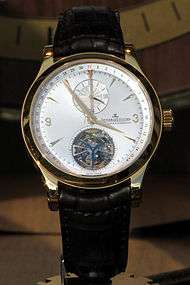 Jaeger-LeCoultre Tourbillon movement watch
Jaeger-LeCoultre Tourbillon movement watch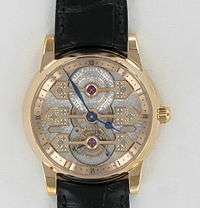 Tourbillon with three gold bridges, Girard-Perregaux
Tourbillon with three gold bridges, Girard-Perregaux
Improved affordability
Several Chinese manufacturers now produce a variety of tourbillon movements.[17] These movements are bought as ébauches by some manufacturers and are sometimes incorporated into watches that meet the requirements of the Federation of the Swiss Watch Industry to be sold as Swiss Made, which requires 60% of the value to have been made in Switzerland.[18] The availability of less expensive tourbillons has led industry spectators to worry that another quartz crisis may occur, where the Swiss watch industry will not be able to adapt quickly to less expensive complicated mechanical watches produced in other countries.[19] In 2016, TAG Heuer began offering the Carrera Heuer-02T tourbillon at a suggested retail price of 14,900 CHF (~US$15,000), significantly lower than the 100,000 CHF or more charged by some other established Swiss watch brands.[20]
References
- Reymondin, Charles-André et al., The Theory of Horology, Switzerland: Swiss Federation of Technical Colleges (FET) [and] the Watchmakers of Switzerland Training and Educational Program Neuchâtel in collaboration with GREME, 1999 (2nd ed., 2005). ISBN 978-2-940025-12-1
- "Watch Accuracy". PrestigeTime.com. Prestige Time, LLC. Retrieved 16 June 2016.
- Jean-Claude Nicolet. "The tourbillon". Europa Star. Retrieved 1 November 2007.
- "The assembling and testing of a tourbillon watch". My Tourbillon. Archived from the original on 21 May 2011. Retrieved 1 June 2011.
- GB 2027232A, Randall, Anthony George, "Timepiece with tourbillon", published 3 August 1978, issued 13 February 1980
- Randall, Anthony G. (September 1981). "The Double Axis Tourbillon". Horological Journal. British Horological Institute. 124 (3): 12–14.
- Randall, Anthony G. (1992). Time Museum Catalogue of Chronometers (1st ed.). Rockford, Illinois: The Time Museum. ISBN 978-0-91294703-7.
- Daniel, George (1985), Watchmaking, Sotheby's, S. 264, ISBN 978-0-85667-497-6.
- Jeanneret, Henri, "Hemmungsträger für industrielle Apparate mit gleich bleibendem Antrieb" [Inhibition support for industrial equipment with a constant drive], Sonderabdruck aus der schweizerischen technischen Zeitschrift Jahrgang (in German), 144, La Chaux-de-Fonds, CH; Zürich, ZH, CH: Verlag ART. Institut Orell Füssli.
- Triple Axis Tourbillon, CH: Prescher.
- About Aaron Becsei, HU: Bexei Watches.
- Primus, HU: Bexei Watches.
- "Uhrmacher Helwig", Alfred Helwig (in German), Glasshütte original.
- "Girard-Perregaux's Tourbillon Icon", WatchTime (article)
|format=requires|url=(help), August 2006. - "Chronocentric: Accuracy of Fine Wristwatches".
- Conner, Andrew (2016-03-04). "Why Do Tourbillons Cost a Small Fortune? The Movement That's Useless, Costly and Beloved". Gear Patrol. Retrieved 2019-08-16.
- "Current Chinese Developments". Tourbillon. Traction ink. Retrieved 1 June 2010.
- "Swiss Made". Federation of the Swiss Watch Industry. Archived from the original on May 23, 2010. Retrieved December 21, 2017.
- Velociphile (August 7, 2005). "New 'Quartz' Crisis Ahead?". Rolex. Watch pro site. Retrieved 1 June 2010.
- Gretler, Corinne. "TAG Heuer to Undercut Rivals With Cheapest Swiss Tourbillon". Bloomberg Pursuits. Retrieved 21 December 2017.
Further reading
- Denny, Mark (June 2010). "The Tourbillon and How It Works". IEEE Control Systems Magazine. IEEE Control Systems Society. 30 (3): 19–99. doi:10.1109/MCS.2010.936291.